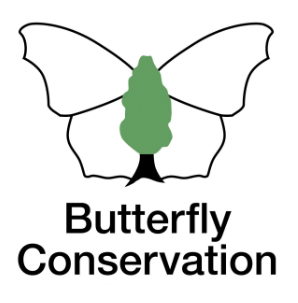Brown Argus
Brown Hairstreak
Chalkhill Blue
Clouded Yellow
Comma
Common Blue
Dark Green Fritillary
Dingy Skipper
Essex Skipper
Gatekeeper
Green Hairstreak
Green-veined White
Grizzled Skipper
Holly Blue
Large Skipper
Large White
Marbled White
Meadow Brown
Orange-tip
Painted Lady
Peacock
Purple Emperor
Purple Hairstreak
Red Admiral
Ringlet
Silver-washed Fritillary
Small Blue
Small Copper
Small Heath
Small Skipper
Small Tortoiseshell
Small White
Speckled Wood
Wall
White Admiral
White-letter Hairstreak
Extinct/rare immigrants
Small Heath
Coenonympha pamphilus
General Distribution and Status
The Small Heath is widespread in Britain and absent only on the highest mountains and the far north of Scotland. It was probably always widespread but many colonies were lost in the last century owing to farming improvement and cessation of grazing. Since the 1970s there is concern that colonies are still dying out and existing colonies at monitored sites much less abundant than they used to be (Brereton et al., Fox et al.). Possible reasons are habitat fragmentation, overgrazing and climate change (Asher et al.). In Hertfordshire and Middlesex, there was a partial recovery at the beginning of 2010s but despite a setback in the middle of the decade (Wood, 2016) numbers have picked up again. Since the 2015-19 period, however, it has been disappointing with abundance well down.
| United Kingdom | Herts & Middx | |||
| Distribution | 1976-2019 | -67% | 1980-2015 | -48% |
| Average 10-year trend | -19% | 2006-2015 | +32% | |
| 2024 since 2015-19 | +35% | |||
| Abundance | 1976-2024 | -43% | 1980-2015 | -60% |
| 2015-2024 | +31% | 2006-2015 | -34% | |
| 2023-2024 | -15% | 2024 since 2015-19 | -16% | |

UK distribution map
UKBMS Species summary
Habitat Requirements
This species is found on grassland where the sward is kept short and is most common on well-drained soils like chalk downland, heaths and coastal dunes. Smaller colonies can occur in woodland rides, roadside verges, disused quarries, waste ground and even large gardens.
Larval Foodplants
Sheep's Fescue Festuca ovina (Thomas & Lewington) is probably most frequently used. Bent Agrostis spp, Meadow-grass Poa spp.
Adult Food Sources
Buttercup Ranunculus sp. (41), Cinquefoil Potentilla sp. (36), Devil's-bit Scabious Succisa pratnsis (25), Common Bird's-foot Trefoil Lotus corniculatus (17).
Historical Records
The earliest reports indicate that the butterfly was common and widespread in Hertfordshire. Foster's 1937 report refers to it as 'abundant everywhere'. It was still common in the 1970s according to Waterton's 1970-81 report.
Local Distribution and Abundance
As shown on the map, the Small Heath occurs in the majority of tetrads in the Stevenage area but curiously the tetrads indicating absence contain grassy habitats which might be suitable for the butterfly. Observations indicate that 2019 was the best year on record with good numbers throughout the flight season but there has been a slight decline since then.

Stevenage (South Fairlands Valley Park) transect 1993-2025
Before the Small Heath disappeared in 2000 the first year of the survey was the best year for the butterfly. All the specimens recorded in the 1990s were found in Canyon Field as it was then known. On 29 May 1993, 12 individuals were seen. The dramatic decline in the 1990s resulted from neglect in this field which became overgrown with shrubs and no patches of fine grasses upon which the butterfly depends. It was not seen again until 2013 when one individual was found about 100 metres north of the Scout Activity Centre. The recent cutting regime in the park may be benefitting the butterfly. 2019 saw a dramatic increase in numbers where most were discovered at Shackledell Grassland and the grassland strip to the west of it. However, 2020 was a disappointing year. One possible reason considering the increase in populations elsewhere is human disturbance of the habitat. The long drought in 2022 probably contributed to a big fall in numbers with only three seen all summer.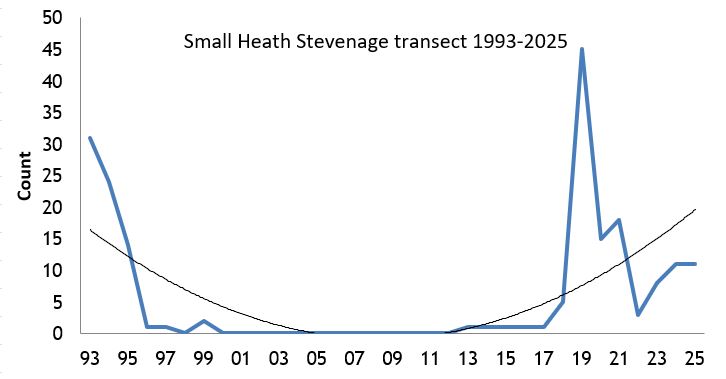
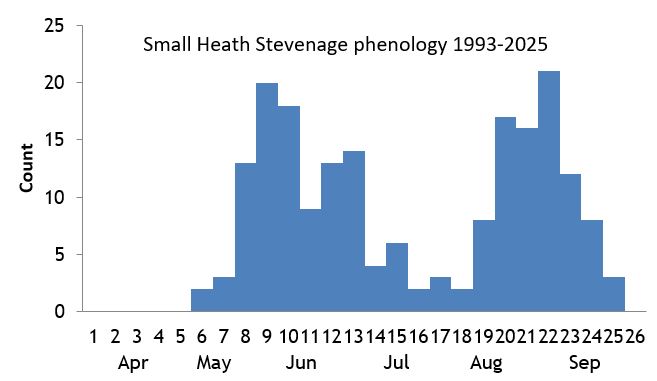
Knebworth Park transect 1996-2010 and 2017-2025
Fortunes continue to improve for this butterfly and 2020 was easily the best year during the survey with most specimens found in the north-western section of the park as in previous years. It is possible that extensive deer grazing has benefited this species although numbers dropped back on 2021. As for the Stevenage transect there was a significant drop in numbers in 2022. A decline occurred in 2024 possibly because of the predominance of coarse grasses in the park itself.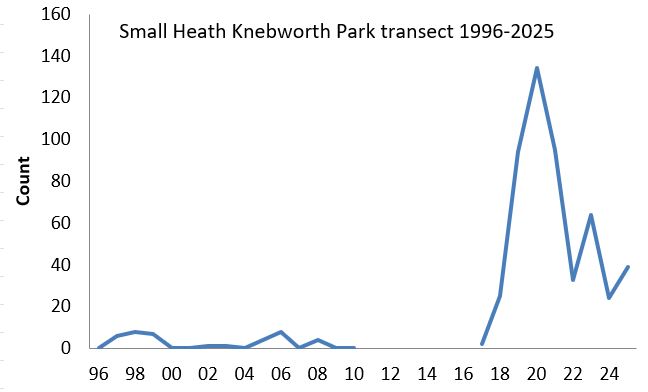
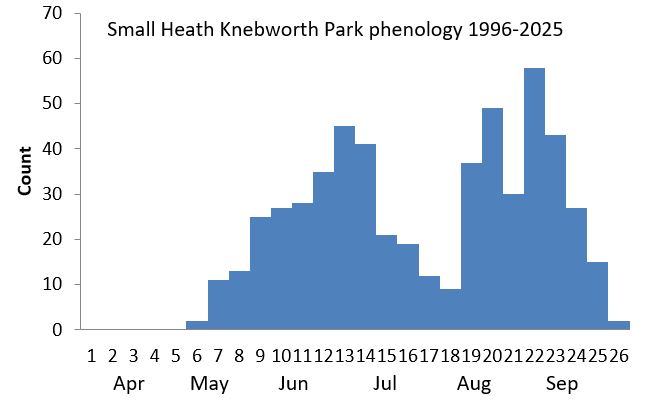
Knebworth Woods transect 2017-2025
No Small Heaths were reported here in 2017 but several were seen in the field just south of Norton Green Common in 2018 and populations continued to increase when in 2020 at least half a dozen individuals would sometimes be seen. Numbers fell in 2021 especially in late summer. Although numbers overall in 2022 were similar to 2021 the vast majority were seen in August and September. A dramatic fall in numbers in 2023 is likely due to coarse grasses allowing to dominate around Norton Green Common in the summer.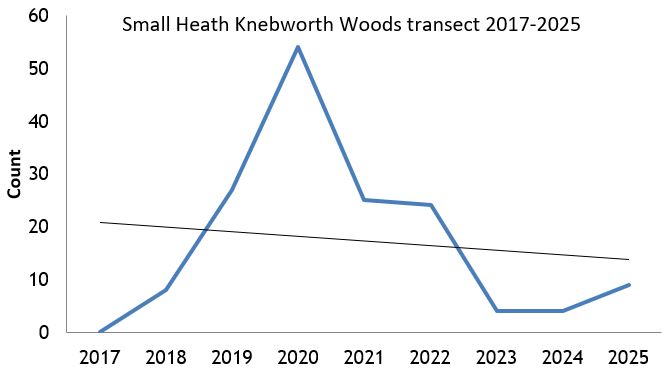
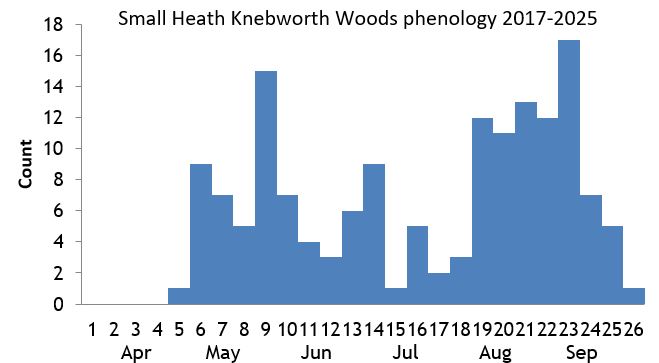
Pryor's Wood transect 2000-2022
2019 was the best year for this species in line with the other two local transects with five specimens counted including three on 20 June. Prior to 2019, only five records (all of single individuals) were recorded in 2006 (2), 2011 (2) and 2015 (1). Three individuals were seen in 2020, one in 2021 and two in 2022.Life History
Earliest date: 3 May 2011 at Frogmore Gravel Pit
Latest date: 1 October 2015 at Frogmore Gravel Pit
Two or three generations
are produced each year but they often overlap so the butterfly can be seen anytime between May and September. About 95% of records used to compile the
phenology chart were from the 1990s coupled with the comparatively small number of records may not totally reflect the situation today. Eggs are laid singly
on a grass blade. Larvae spend much of their time at the bottom of a tuft of grass but will feed at night on the grass tips (Eeles).
Larvae will either hibernate or develop to form pupae suspended on a grass stem.
Behaviour/Observation notes
Males are very active when patrolling over open grassland around a suitable landmark in search for females but in the early morning or during cloudy weather they should be more approachable when perched on the ground. Mated females will stay in the vicinity of the foodplants and can be approached with ease. The butterfly always basks with its wings closed.
Variations/Aberrations
There is a form ssp. rhoumensis from Scotland where the specimens are duller than the English form with the hindwing undersides
looking mainly grey and the white band narrower or absent. There are many classified aberrations in relation to the colouring and markings on the wings but
none have been reported from Hertfordshire.
Find out more on the UK Butterflies website
References
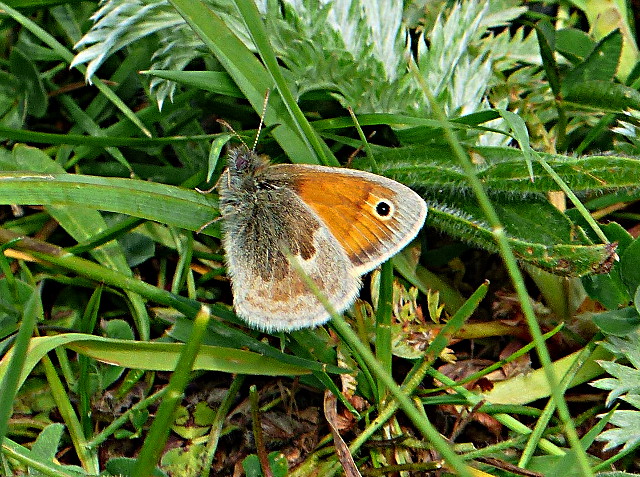
Watery Grove 28 May 2016 (m)
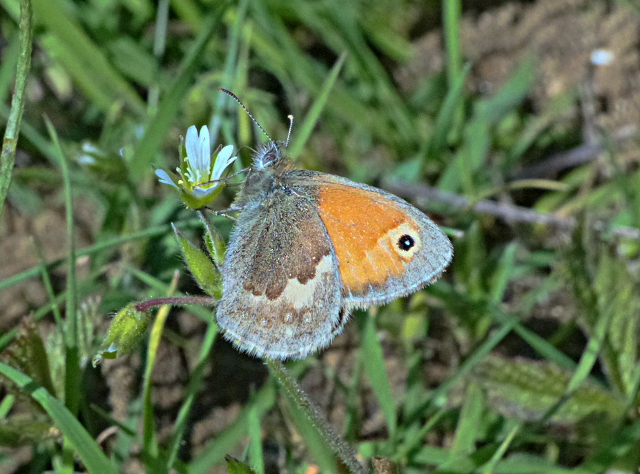
Bareleigh 11 Aug 2017 (f)
